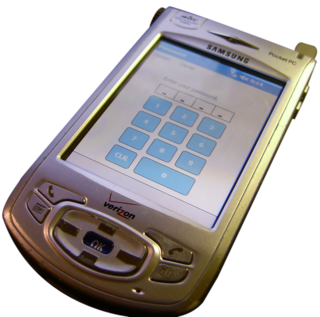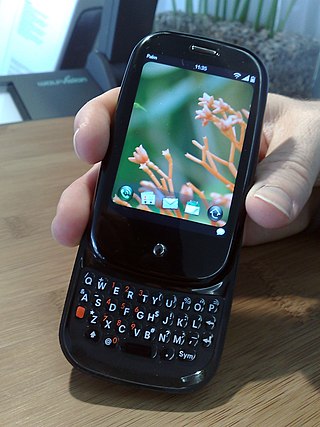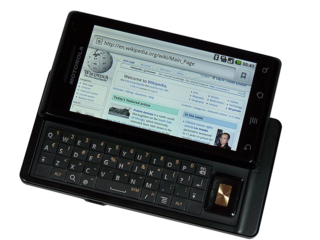
Motorola, Inc. was an American multinational telecommunications company based in Schaumburg, Illinois. It was founded in 1928 as Galvin Manufacturing Corporation by brothers Paul and Joseph Galvin. The company changed its name to Motorola in 1947. After having lost $4.3 billion from 2007 to 2009, Motorola was split into two independent public companies, Motorola Mobility and Motorola Solutions, on January 4, 2011. The reorganization was structured with Motorola Solutions legally succeeding Motorola, Inc., and Motorola Mobility being spun off.

A wearable computer, also known as a body-borne computer, is a computing device worn on the body. The definition of 'wearable computer' may be narrow or broad, extending to smartphones or even ordinary wristwatches.

Adobe Flash Lite was a lightweight version of Adobe Flash Player, a software application published by Adobe Systems for viewing Flash content. Flash Lite operates on devices that Flash Player cannot, such as mobile phones and other portable electronic devices like Wii, Chumby and Iriver.

Windows SideShow was a feature by Microsoft introduced in Windows Vista to supply information such as e-mail, instant messages, and RSS feeds from a personal computer to a local or remote peripheral device or display. SideShow was intended to enhance the Windows experience by enabling new mobility scenarios for the Windows platform and by providing power saving benefits as part of Microsoft's broader efforts regarding a mobile initiative.

The SPH-i700 is a Windows Mobile-powered smartphone manufactured by Samsung of Korea. It is a powerful and expandable second generation Pocket PC phone compared to others in its class. It includes a transflective display, a VGA camera, 300 MHz Processor and supports SDIO, making it a competent PDA. It includes a complete bundle of accessories, including: a case, stereo headset-mic, cradle and both a regular and extended battery. The wireless radio was reported to get strong signals, and offered good voice quality and fast data speeds on Verizon's Express Network. The unit runs the Pocket PC 2002 Phone Edition OS, and in July 2004, Verizon started shipping units running Windows Mobile 2003 Phone Edition. Windows Mobile 2003 Phone Edition offers the same improvements found in regular Pocket PCs running this OS: improved Pocket Internet Explorer, always on networking, an improved networking connection manager and overall speed improvements. Samsung makes a similar model called the SGH-i700 which is identical to the SPH-i700 except for it works on the GSM/GPRS network.
Motorola Rizr is a series of slide mobile phones from Motorola, and is one of the series in the 4LTR line. The first model was released in late 2006. It is a sliding phone, where the numeric keys are hidden beneath the screen of the phone when closed.
The Motorola Ming is a series of smartphones from Motorola, sold in Hong Kong and mainland China only. It is one of the series in the 4LTR line.

The Palm Pre, styled as palm prē, is a multitasking smartphone that was designed and marketed by Palm with a multi-touch screen and a sliding keyboard. The smartphone was the first to use Palm's Linux-based mobile operating system, webOS. The Pre functions as a camera phone and a portable media player, and has location and navigation capabilities. The Pre also serves as a personal information manager, has a number of communication and collaboration applications, and has Bluetooth and Wi-Fi connectivity built-in.

The Motorola Droid is an Internet and multimedia-enabled smartphone designed by Motorola, which runs Google's Android operating system. The Droid had been publicized under the codenames Sholes and Tao and the model number A855. In Latin America and Europe, the model number is A853 (Milestone), and in Mexico, the model number is A854 (Motoroi). Due to the ambiguity with newer phones with similar names, it is also commonly known as the DROID 1. The brand name Droid is a trademark of Lucasfilm licensed to Verizon Wireless.

The HTC Droid Incredible (ADR6300) is a smartphone manufactured by HTC Corporation using the Android operating system. It was released on April 29, 2010, and is available through Verizon Wireless only. The device is similar to the Sprint HTC Evo 4G. The device has been succeeded by the HTC Incredible S and the HTC ThunderBolt. The device was discontinued in March 30, 2011.

A smartwatch is a wearable computer in the form of a watch; modern smartwatches provide a local touchscreen interface for daily use, while an associated smartphone app provides management and telemetry, such as long-term biomonitoring. While early models could perform basic tasks such as calculations, digital time telling, translations, and game-playing, smartwatches released since 2015 have more general functionality closer to smartphones, including mobile apps, a mobile operating system, and WiFi/Bluetooth connectivity. Some smartwatches function as portable media players, with FM radio and playback of digital audio and video files via a Bluetooth headset. Some models, called watch phones, have mobile cellular functionality such as making telephone calls.
Telenav, Inc. is a wireless location-based services corporation that provides services including Global Positioning System (GPS) satellite navigation, local search, automotive navigation solutions, mobile advertising, enterprise mobility and workflow automation. The company’s headquarters are located in Santa Clara, California in the United States with additional offices in the U.S., Germany, Japan, Romania, China, and Brazil.

The Motorola Xoom is an Android-based tablet computer by Motorola, introduced at CES 2011 on January 5, 2011. It was the first tablet to be sold with Android 3.0 Honeycomb. The Verizon branded Xoom was the first tablet to run Android 3.1. The Motorola Xoom went through the FCC on February 10, 2011 only 14 days before release. The 3G version was released on February 24, 2011, and the Wi-Fi version was released March 27, 2011. It was announced concurrently with three other products: the Motorola Atrix, the Motorola Droid Bionic, and the Motorola Cliq 2. CNET named it the "Best of the CES" 2011.
Vuzix is an American multinational technology company headquartered in Rochester, New York and founded by Paul Travers in 1997. Vuzix is a supplier of wearable virtual reality and augmented reality display technology. Vuzix manufactures and sells computer display devices and software. Vuzix head-mounted displays are marketed towards mobile and immersive augmented reality applications, such as 3D gaming, manufacturing training, and military tactical equipment. On January 5, 2015, Intel acquired 30% of Vuzix's stock for $24.8 million.

Recon Instruments was a Canadian technology company that produced smartglasses and wearable displays marketed by the company as "heads-up displays" for sports. Recon's products delivered live activity metrics, GPS maps, and notifications directly to the user's eye. Recon's first heads-up display offering was released commercially in October 2010, roughly a year and a half before Google introduced Google Glass.
The Droid Maxx is a smartphone developed by Motorola Mobility. It is the first Droid to be a high end smartphone exclusively developed by Motorola for Verizon Wireless. It is part of the Verizon Droid line, and was announced on 23 July 2013 along with the Droid Ultra and Droid Mini at a joint Motorola and Verizon Wireless press conference.
The Kopin Corporation is a Westborough, Massachusetts-based electronics manufacturer, best known for its display devices for mobile electronics.

Windows Mixed Reality (WMR) is a discontinued platform by Microsoft which provides augmented reality and virtual reality experiences with compatible head-mounted displays.

Hearables or smart headphones or earbuds are electronic in-ear devices designed for multiple purposes. The category is split between hearables for hearing health, and hearables for other applications.
The Moto 360 , also known as the Moto 360 (2015), is an Android Wear-based smartwatch. It was announced on September 14, 2015 at the IFA.













